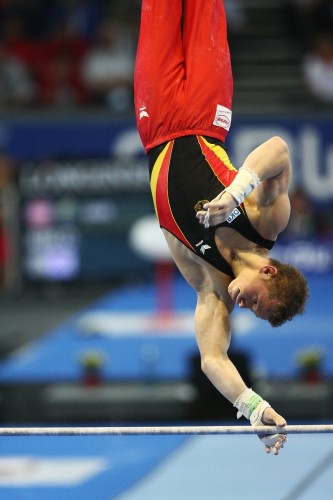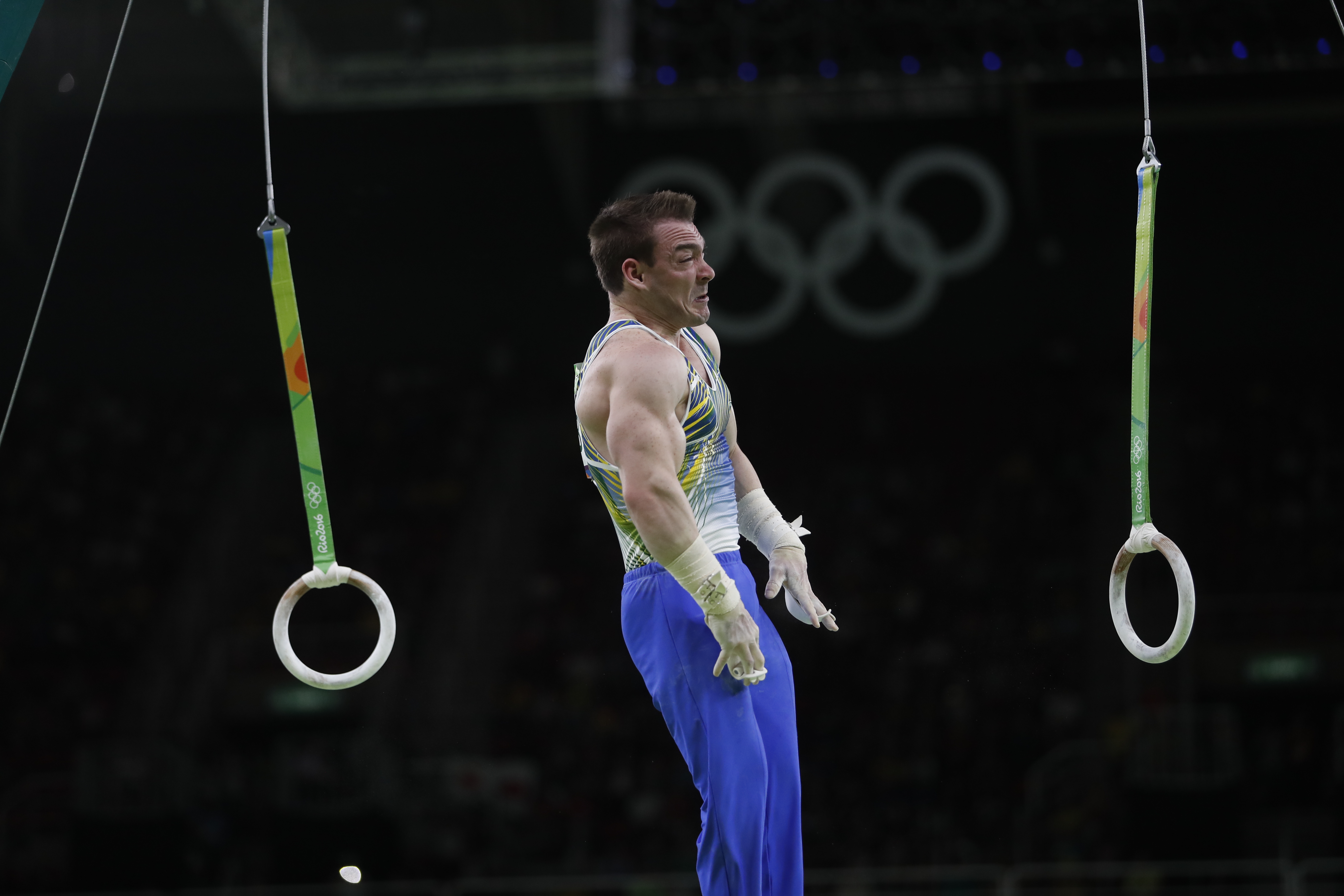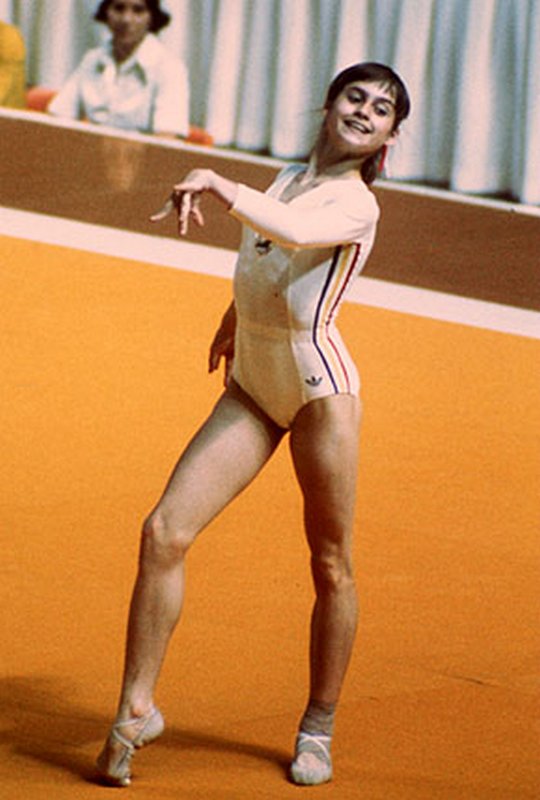|
Hand Guard
Hand guards are devices worn by athletes in artistic gymnastics. Various types of hand guards are used by gymnasts: * Grips are used on the uneven bars, high bar, still rings and parallel bars to enhance the gymnast's grip and, in the case of bar exercises, to reduce friction between the gymnast's hands and the bar. * Hand braces do not offer the gymnast any performance advantage, but help to prevent injury by providing support and lessening impact on the wrists and hands. * Wrist guards are usually worn by male gymnasts performing on the pommel horse, and sometimes by female gymnasts on the floor exercise In gymnastics, the floor is a specially prepared exercise surface, which is considered an apparatus. It is used by both male and female gymnasts. The gymnastics event performed on the floor is called floor exercise. The English abbreviation for t ... or vault. {{DEFAULTSORT:Hand Guard Gymnastics apparatus Protective gear Handwear ... [...More Info...] [...Related Items...] OR: [Wikipedia] [Google] [Baidu] |
Artistic Gymnastics
Artistic gymnastics is a discipline of gymnastics in which athletes perform short routines on different apparatuses. The sport is governed by the Fédération Internationale de Gymnastique (FIG), which designs the Code of Points and regulates all aspects of elite international competition. Within individual countries, gymnastics is regulated by national federations like British Gymnastics and USA Gymnastics. Artistic gymnastics is a popular spectator sport at many competitions, including the Summer Olympic Games. History The gymnastic system was mentioned in writings by ancient authors, including Homer, Aristotle, and Plato. It included many disciplines that later became independent sports, such as swimming, racing, wrestling, boxing, and horse riding. It was also used for military training. In its present form, gymnastics evolved in Bohemia and what is now known as Germany at the beginning of the 19th century. The term "artistic gymnastics" was introduced to distingui ... [...More Info...] [...Related Items...] OR: [Wikipedia] [Google] [Baidu] |
Grip (gymnastics)
Grips are devices that are worn on the hands of artistic gymnasts when performing on various apparatus. They are worn by female gymnasts on the uneven bars, and by male gymnasts on the high bar and still rings; it is rare to wear them on the parallel bars. Grips are used to enhance the gymnast's grip on the apparatus and to reduce friction, which can cause painful blisters and ''rips'', in which outer layers of skin separate and tear away from the hand. Grips are optional and are not used by all gymnasts. Some athletes substitute sports tape or gauze for grips, while others use bare hands. Most gymnasts apply powdered chalk (typically magnesium carbonate) to their grips, or to their hands if not using grips so that they do not slip. Construction A grip consists of a wide strip of leather joined to a wrist strap. The leather strip, which covers and protects the palm of the hand, is approximately five centimeters wide and has finger holes at one end. On properly fitted grips, th ... [...More Info...] [...Related Items...] OR: [Wikipedia] [Google] [Baidu] |
Uneven Bars
The uneven bars or asymmetric bars is an artistic gymnastics apparatus. It is made of a steel frame. The bars are made of fiberglass with wood coating, or less commonly wood. The English abbreviation for the event in gymnastics scoring is UB or AB, and the apparatus and event are often referred to simply as "bars". The bars are placed at different heights and widths, allowing the gymnast to transition from bar to bar. A gymnast usually adds white chalk to the hands so that they can grip the bar better. The apparatus Uneven bars used in international gymnastics competitions must conform to the guidelines and specifications set forth by the International Gymnastics Federation Apparatus Norms brochure. Several companies manufacture and sell bars, including AAI in the United States, Jannsen and Fritsen in Europe, and Acromat in Australia. Many gyms also have a single bar or a set of uneven bars over a loose foam pit or soft mat for learning new skills to provide an additional le ... [...More Info...] [...Related Items...] OR: [Wikipedia] [Google] [Baidu] |
High Bar
The horizontal bar, also known as the high bar, is an apparatus used by male gymnasts in artistic gymnastics. It traditionally consists of a cylindrical metal (typically steel) bar that is rigidly held above and parallel to the floor by a system of cables and stiff vertical supports. Gymnasts typically wear suede leather grips while performing on the bar. Current elite-level competition uses a stainless steel core rail. The gymnastics elements performed on the horizontal bar are regulated by a Code of Points. A bar routine, which is a sequence of several bar skills, usually includes giants with various grips (overgrip, undergrip, dorsal grip, mixed grip), in-bar work, turns, release and regrasp skills, and a dismount. The horizontal bar is often considered one of the most exciting gymnastics events due to the power exhibited by gymnasts during giant swings and spectacular aerial releases and dismounts that often include multiple flips or twists and, in some cases, airborne tr ... [...More Info...] [...Related Items...] OR: [Wikipedia] [Google] [Baidu] |
Still Rings
The rings, also known as still rings (in contrast to flying rings), is an artistic gymnastics apparatus and the event that uses it. It is traditionally used only by male gymnasts, due to its extreme upper body strength requirements. Gymnasts often wear ring grips while performing. The apparatus The apparatus consists of two rings that hang freely from a rigid metal frame. Each ring is supported by a strap, which in turn connects to a steel cable that is suspended from the metal frame. The gymnast, who grips one ring with each hand, must control the movement of the rings and his or her body movements at all times. Dimensions The measurements of the standard apparatus are specified by Fédération Internationale de Gymnastique (FIG) in its ''Apparatus Norms'' document: * Inner diameter: ± * Diameter of profile: ± * Distance from point of attachment to lower inner side of the rings: ± * Distance between two points of attachment: ± Routines An exercise on rings ... [...More Info...] [...Related Items...] OR: [Wikipedia] [Google] [Baidu] |
Parallel Bars
Parallel bars are floor apparatus consisting of two wooden bars slightly over long and positioned at roughly head height. Parallel bars are used in artistic gymnastics and also for physical therapy and home exercise. Gymnasts may optionally wear grips when performing a routine on the parallel bars, although this is uncommon. Apparatus The apparatus consists of two parallel bars that are held parallel to, and elevated above, the floor by a metal supporting framework. The bars are composed of wood or other material, with an outer coating of wood. The vertical members of the supporting framework are adjustable so the height of the bars above the floor and distance between the bars can be set optimally for each gymnast. Dimensions *Bar length: ± *Bar rounded profile: ± vertical by ± horizontal *Bar width: ± *Height of bar from floor: ± *Distance between bars: – (adjustable) History The parallel bars (in German ''Barren'') were invented by Friedrich Ludwi ... [...More Info...] [...Related Items...] OR: [Wikipedia] [Google] [Baidu] |
Hand Braces
A hand is a prehensile, multi-fingered appendage located at the end of the forearm or forelimb of primates such as humans, chimpanzees, monkeys, and lemurs. A few other vertebrates such as the koala (which has two opposable thumbs on each "hand" and fingerprints extremely similar to human fingerprints) are often described as having "hands" instead of paws on their front limbs. The raccoon is usually described as having "hands" though opposable thumbs are lacking. Some evolutionary anatomists use the term ''hand'' to refer to the appendage of digits on the forelimb more generally—for example, in the context of whether the three digits of the bird hand involved the same homologous loss of two digits as in the dinosaur hand. The human hand usually has five digits: four fingers plus one thumb; these are often referred to collectively as five fingers, however, whereby the thumb is included as one of the fingers. It has 27 bones, not including the sesamoid bone, the number of wh ... [...More Info...] [...Related Items...] OR: [Wikipedia] [Google] [Baidu] |
Wrist Guards
A wrist-guard is a device to protect the wrist. Wrist-guards are sold in skateboard, snowboard and sporting goods stores. They are worn also by people using a balance board. Purpose The purpose of a wrist guard is to prevent the wearer from injuring their wrist or arm when falling. When a person falls forward, the typical reflex is to stretch their hands out in front of them to break the fall. In particularly violent or fast falls that are often associated with extreme sports, the forces associated with the fall can be large enough to cause severe bruising, dislocation or fracture of the wrist and arm bones. Wrist-guards prevent such injury with a plastic splint held on the inside of the wrist. The splint curves inwards towards the palm at the wrist joint, where it is exposed, and is concealed and held in place by padding at the hand and arm. When the wearer falls forward onto their hands, the curved plastic splint prevents the hand from hitting the ground, and the reduced fri ... [...More Info...] [...Related Items...] OR: [Wikipedia] [Google] [Baidu] |
Pommel Horse
The pommel horse is an artistic gymnastics apparatus. Traditionally, it is used by only male gymnasts. Originally made of a metal frame with a wooden body and a leather cover, the modern pommel horse has a metal body covered with foam rubber and leather, with plastic handles (or pommels). Apparatus History The apparatus originates from the Romans, who used wooden horses to teach mounting and dismounting. They later added it to the ancient Olympic Games. The basic modern exercises were developed in the early 19th century by Friedrich Ludwig Jahn, founder of the German Turnverein. Dimensions Measurements of the apparatus are published by the Fédération Internationale de Gymnastique (FIG) in the ''Apparatus Norms'' brochure. * Height from top surface to floor: ± * Length at top: ± * Length at bottom: ± * Width at top: ± * Width at bottom: ± * Height of the pommels: ± * Distance between the pommels: – (adjustable) Routines A typical pommel horse e ... [...More Info...] [...Related Items...] OR: [Wikipedia] [Google] [Baidu] |
Floor Exercise
In gymnastics, the floor is a specially prepared exercise surface, which is considered an apparatus. It is used by both male and female gymnasts. The gymnastics event performed on the floor is called floor exercise. The English abbreviation for the event in gymnastics scoring is FX. A spring floor is used in all of gymnastics to provide more bounce, and also help prevent potential injuries to lower extremity joints of gymnasts due to the nature of the apparatus, which includes the repeated pounding required to train it. Cheerleading also uses spring floors for practice. The sprung floor used for indoor athletics, however, is designed to reduce bounce. The apparatus The apparatus originated as a 'free exercise' for men, very similar to the floor exercise of today. Most competitive gymnastics floors are spring floors. They contain springs and/or a rubber foam and plywood combination which make the floor bouncy, soften the impact of landings, and enable the gymnast to gain height ... [...More Info...] [...Related Items...] OR: [Wikipedia] [Google] [Baidu] |
Vault (gymnastics)
The vault is an artistic gymnastics apparatus which gymnasts perform on, as well as the skill performed using that apparatus. Vaulting is also the action of performing a vault. Both male and female gymnasts perform the vault. The English abbreviation for the event in gymnastics scoring is VT. The apparatus Early forms of the vault were invented by German Friedrich Ludwig Jahn. The apparatus itself originated as a "horse", much like the pommel horse but without the handles; it was sometimes known as the vaulting horse. The horse was set up with its long dimension perpendicular to the run for women, and parallel for men.What's With That Weird New Vault? an August 2004 "Explainer" article from '''' [...More Info...] [...Related Items...] OR: [Wikipedia] [Google] [Baidu] |
Gymnastics Apparatus
Gymnastics is a type of sport that includes physical exercises requiring balance, strength, flexibility, agility, coordination, dedication and endurance. The movements involved in gymnastics contribute to the development of the arms, legs, shoulders, back, chest, and abdominal muscle groups. Gymnastics evolved from exercises used by the ancient Greeks that included skills for mounting and dismounting a horse, and from circus performance skills. The most common form of competitive gymnastics is artistic gymnastics (AG), which consists of, for women (WAG), the events floor, vault, uneven bars, and beam; and for men (MAG), the events floor, vault, rings, pommel horse, parallel bars, and horizontal bar. The governing body for gymnastics throughout the world is the Fédération Internationale de Gymnastique (FIG). Eight sports are governed by the FIG, which include gymnastics for all, men's and women's artistic gymnastics, rhythmic gymnastics, trampolining (including double min ... [...More Info...] [...Related Items...] OR: [Wikipedia] [Google] [Baidu] |









